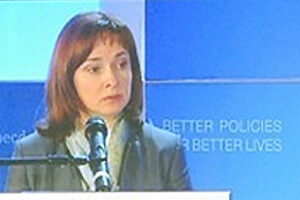Fractures Form Inside Russia’s Central Bank as Recession Deepens

(Bloomberg – bloomberg.com – Evgenia Pismennaya, Ilya Arkhipov – August 12, 2015)
In his first stint as a top Russian central bank official in the early 1990s, Dmitry Tulin saw how flooding cheap credit to dying industrial giants delivered hyperinflation instead of growth.
Now back as the bank’s monetary chief, Tulin, 59, has argued internally for easier credit and more targeted lending to industry to revive an economy driven into recession by plunging oil prices and U.S. and European sanctions, say officials who have attended meetings with him. They discussed internal bank deliberations on condition of anonymity.
While Tulin isn’t pushing for a repeat of the failed Soviet-style policies of the early 1990s, his challenge to the orthodox approach of his boss at the central bank, Governor Elvira Nabiullina, underscores the tension facing Russia’s economic policy makers as they try to steady an economy battered largely by forces beyond their control.
“The external environment is very difficult: geopolitical tensions, sanctions, rising capital outflows, a sharp drop in economic activity, a strengthening of restrictive and regulatory moves by the authorities,” said Alexei Kudrin, a former finance minister who now runs a think tank. “Nabiullina, an advocate of traditional, market-based policies, is trying as best she can to maintain her balance in this very unstable situation.”
While Russian officials say publicly the worst of the economic turmoil has passed, they say in private that the situation is fragile at best and the central bank’s $358 billion in reserves could be drained further if crude prices continue to drop.
Economic Slump
Russia’s economy contracted 4.6 percent in the second quarter, its weakest performance since 2009, and the Economy Ministry has said it might cut full-year forecasts. A renewed slide in oil prices has dragged the ruble to a six-month low against the dollar, further limiting the central bank’s room for maneuver and raising the stakes for Tulin’s policy debate.
His arguments have already contributed to shifts, helping drive the bank to cut interest rates quickly in recent months and begin to rebuild its foreign-exchange reserves, officials said.
Tulin advocates more assertive steps to manage the exchange rate, which has lost almost half its value against the dollar since the Ukraine crisis began last year. He has gone as far as questioning bank opposition to restricting international capital flows. He has argued that lifting capital controls in 2006 was a mistake and re-imposing some limits could be justified to steady the ruble, according to officials familiar with his thinking.
Capital Controls
So far, Nabiullina’s view that capital controls would do more harm than good remains policy. The officials said there’s no sign yet of open conflict between Nabiullina and Tulin. As monetary chief, he has emerged as her most influential deputy, officials said.
Still, his positions also reflect views widely held in the Kremlin and the government, where many back the kind of direct intervention in the economy that Russia hasn’t seen since the early 1990s, officials say.
The central bank already has pumped trillions of rubles into the economy as the slump deepened. In the first half, lending to banks averaged 5.4 trillion rubles a day — up 20 percent from the year before, according to official data.
The central bank’s press service declined to comment on any differences between Nabiullina and Tulin.
Team Player
Facing political pressure after the ruble’s plunge in December when the currency dropped as much as 20 percent in a single day, Nabiullina brought Tulin on board in January. He was chosen to help placate critics who had accused the bank’s leadership of being out of touch, senior officials said. At the time, Nabiullina, a 51-year-old Putin appointee, praised him as “very responsible.”
In a March interview with Interfax, Tulin described himself as a “team player.”
He’s been a fixture on Moscow’s banking scene since the early 1990s. He began his career at Gosbank, the Soviet central bank, and became a deputy chairman at its Russian successor after the Soviet collapse.
No advocate of easy money — he served as Russia’s representative to the International Monetary Fund in the 1990s – – he has likened the bank’s role to that of one of a team making a suit, colleagues said. Even if the individual tailor sewed only the buttons, he still shares responsibility if the suit fits badly.
Targeted Support
He has argued in internal deliberations for targeting central-bank support to specific sectors, including grain farming and gold mining, according to officials.
“If our financial system doesn’t turn its face toward material production, then our country won’t have a future,” Tulin said in an April 23 interview in tabloid Komsomolskaya Pravda.
But his calls for expanding a 100 billion-ruble program for targeted cheap loans to manufacturers and farmers have run into opposition from Nabiullina. She has said the program doesn’t work and shouldn’t grow, while Tulin has written letters to senior government ministers sugggesting the bank could offer more money, according to officials.
“It’s an illusion to think that if we give everyone cheap loans that will get the economy growing,” said Sergey Dubinin, who came in as chairman of the central bank about a year after Tulin left as deputy in 1994 and is now a board member at state bank VTB. “We went through that in 1992-1993, when we gave everyone loans and wound up with 1000% inflation.”
Article ©2015 Bloomberg L.P. All Rights Reserved. Article also appeared at bloomberg.com/news/articles/2015-08-13/fractures-form-inside-russia-s-central-bank-as-recession-deepens
[featured image is file photo]
